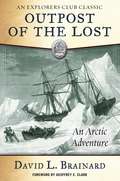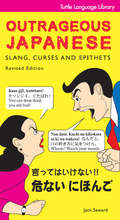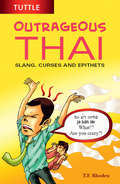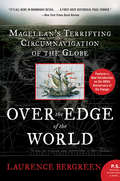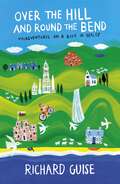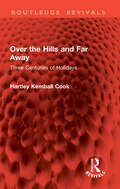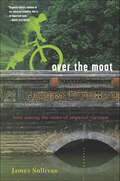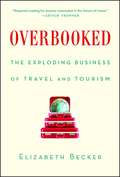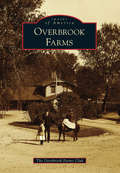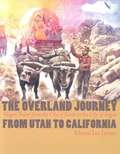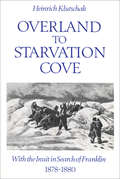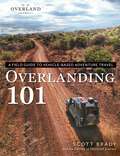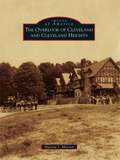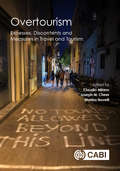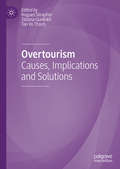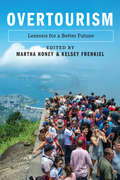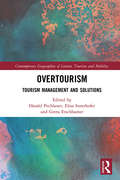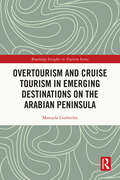- Table View
- List View
The Outlaws of Ennor (Last Templar Mysteries 16): A devishly plotted medieval mystery
by Michael JecksSeparated, but working on the same mystery, what will befall Sir Baldwin and Simon Puttock after a devastating shipwreck? The brooding Scilly Isles provide the backdrop to Michael Jecks' absorbing sixteenth mystery, The Outlaws of Ennor, featuring the ever-popular Sir Baldwin de Furnshill and Bailiff Simon Puttock. Perfect for fans of Susanna Gregory and C.J. Sansom. 'Tremendously successful medieval mystery series' - Sunday Independent On the return from their pilgrimage to Santiago de Compostela, in the summer of 1323, Sir Baldwin de Furnshill and Bailiff Simon Puttock's ship is attacked by pirates. They fight their attackers off, but then there are too few shipmen when a terrible storm strikes. As the ship breaks up, Simon sees Baldwin washed overboard. Distraught, Simon makes his way to shore.But on the island of Ennor, he must put aside his fears and investigate the murder of Robert, the island's hated tax collector, at the behest of master of the castle, Ranulph de Blancminster.Meanwhile, washed up on the other side of the island, Baldwin begins his own investigation of the same murder. As the friends dig deeper, they become embroiled in a bitter rivalry between the two island communities. Can they uncover the truth in time to prevent certain massacre? What readers are saying about The Outlaws of Ennor: 'Michael's books are full of intrigue and mystery and they are particularly well researched''What a great book this was...Michael Jecks is a great writer and in this genre, I don't think you will find anyone better''Five stars'
The Outpost of the Lost: An Arctic Adventure
by David L. Brainard Geoffrey E. ClarkIn the summer of 1881, Lt. Adolphus Greely of the Fifth United States Cavalry and a crew of twenty-one men set out on the Proteus to explore the then relatively-unknown Arctic Circle. During their three-year journey, the Lady Franklin Bay expedition, as it came to be known, was meant to ascertain new astronomical data, to establish an observation station, and to record other meteorological data. And while they did accomplish those tasks, the crew of the Proteus will instead forever be remembered for the catastrophe that they encountered, one that yielded few survivors. After a relatively calm first year in the Arctic, the members of the Lady Franklin Bay Expedition grew increasingly desperate as ships carrying essential supplies—food, clothing, and building materials, among other items—failed to reach them due to increasingly perilous conditions. Slowly but surely the harsh weather and low supplies decimated the crew, as one by one they succumbed to the merciless Arctic. When a rescue vessel finally reached the Proteus in 1884, only six members of the original expedition remained. Told in concise prose with stunning clarity, Proteus crew member David L. Brainard's Outpost of the Lost is an inspiring account of human spirit and perseverance, and is not be missed by any armchair adventurer or history buff.
Outrageous Japanese
by Jack SewardThis is a user-friendly and concise Japanese phrase book and guide to Japanese slang and Japanese curses.The Japanese are extraordinarily polite and soft-spoken people who are always indirect and evasive in their dealings with each other. Right? Well, not really. They can be just as explicit, vicious, vile and downright vulgar as anyone else when they want to be. This little gem of a book teaches you hundreds and hundreds of Japanese taunts, threats, curses and expletives that you'll never find in any dictionary-showing you how the Japanese really talk to one another when they are angry or emotional. Fun and entertaining, it will help you to read Japanese, write Japanese, and speak Japanese. It leaves no taboo untouched and sets the record straight. Learn how to call somebody a lecher, a deadbeat, a tub of lard, (and much worse than we can show here)-and arm yourself with phrases such as "Drop dead" or "what sewer did you crawl out of jackass? Fun and instructive, it is the perfect antidote for those boring language classes you have been taking, and your Japanese friends will die when they hear you trying out new expressions like tonji (pig-child) and dauma-geisha (fat-bottomed geisha).
Outrageous Japanese
by Jack SewardThis is a user-friendly and concise Japanese phrase book and guide to Japanese slang and Japanese curses.The Japanese are extraordinarily polite and soft-spoken people who are always indirect and evasive in their dealings with each other. Right? Well, not really. They can be just as explicit, vicious, vile and downright vulgar as anyone else when they want to be. This little gem of a book teaches you hundreds and hundreds of Japanese taunts, threats, curses and expletives that you'll never find in any dictionary-showing you how the Japanese really talk to one another when they are angry or emotional. Fun and entertaining, it will help you to read Japanese, write Japanese, and speak Japanese. It leaves no taboo untouched and sets the record straight. Learn how to call somebody a lecher, a deadbeat, a tub of lard, (and much worse than we can show here)-and arm yourself with phrases such as "Drop dead" or "what sewer did you crawl out of jackass? Fun and instructive, it is the perfect antidote for those boring language classes you have been taking, and your Japanese friends will die when they hear you trying out new expressions like tonji (pig-child) and dauma-geisha (fat-bottomed geisha).
Outrageous Japanese
by Jack SewardThis is a user-friendly and concise Japanese phrase book and guide to Japanese slang and Japanese curses.The Japanese are extraordinarily polite and soft-spoken people who are always indirect and evasive in their dealings with each other. Right? Well, not really. They can be just as explicit, vicious, vile and downright vulgar as anyone else when they want to be. This little gem of a book teaches you hundreds and hundreds of Japanese taunts, threats, curses and expletives that you'll never find in any dictionary-showing you how the Japanese really talk to one another when they are angry or emotional. Fun and entertaining, it will help you to read Japanese, write Japanese, and speak Japanese. It leaves no taboo untouched and sets the record straight. Learn how to call somebody a lecher, a deadbeat, a tub of lard, (and much worse than we can show here)-and arm yourself with phrases such as "Drop dead" or "what sewer did you crawl out of jackass? Fun and instructive, it is the perfect antidote for those boring language classes you have been taking, and your Japanese friends will die when they hear you trying out new expressions like tonji (pig-child) and dauma-geisha (fat-bottomed geisha).
Outrageous Thai: Slang, Curses and Epithets (Thai Phrasebook)
by T. F. RhodenThis is a user-friendly and concise Thai phrase book and guide to Thai slang and Thai curses.The Thai people love fun and laughter. They appreciate foreigners who speak their language.<P><P> But how would they react to foreigners who throw insults in the Thai language and know how to make them blush at the use of direct and vulgar Thai words? This Thai phrasebook, while designed to teach non-Thais to understand that spoken language on the street or in everyday life, also teachers powerful words. So, be cautious. A non-Thai, will appreciate the opportunity to learn some really strong and direct language that his Thai colleagues would rather he not know. Learn how to call someone hot or ugly, a walrus or a potbelly, stupid or a hypocrite. Know how to put off lechers by saying "Piss off!" in the strongest possible way. Not just a simple phrasebook, Outrageous Thai teaches how to really speak Thai, and understand the Thai language. Know what Thais really mean and answer back. Features of this Thai phrasebook are:Compact travel sizeHundreds of colorful Thai phrases organized by topic and useExtensive explanations of context and cultureAll phrases shown in written Thai script, Romanized Thai and English
Outside My Window
by Linda AshmanA joyous glimpse into different cultures Children living in different parts of the world see very different things when they gaze out of their windows. One child looks out over a boulevard lined with palm trees, another sees a train whistling past snow-capped mountains, and another waves to her father as he tends to their garden. But while their lives may seem different, there&’s something important that they all share. This beautiful book will spark readers&’ curiosity and imagination with its celebration of global diversity.
Over The Edge: Death In Grand Canyon
by Michael P. Ghiglieri Thomas M. MyersGripping accounts of all known fatal mishaps in the most famous of the World's Seven Natural Wonders. Two veterans of decades of adventuring in Grand Canyon chronicle the first complete and comprehensive history of Canyon misadventures. These episodes span the entire era of visitation from the time of the first river exploration by John Wesley Powell and his crew of 1869 to that of tourists falling off its rims in Y2K. These accounts of the 550 people who have met untimely deaths in the Canyon set a new high water mark for offering the most astounding array of adventures, misadventures, and life saving lessons published between any two covers. Over the Edge promises to be the most intense yet informative book on Grand Canyon ever written.
Over the Edge of the World: Magellan's Terrifying Circumnavigation of the Globe
by Laurence BergreenFerdinand Magellan's daring circumnavigation of the globe in the sixteenth century was a three-year odyssey filled with sex, violence, and amazing adventure. Now in Over the Edge of the World, prize-winning biographer and journalist Laurence Bergreen entwines a variety of candid, firsthand accounts, bringing to life this groundbreaking and majestic tale of discovery that changed both the way explorers would henceforth navigate the oceans and history itself.
Over the Hill and Round the Bend: Misadventures on a Bike in Wales
by Richard GuiseWanting to explore Wales by bicycle, Richard Guise sets off on a 567-mile trek that leads him through the Cambrian mountains, to picturesque towns and Cardigan Bay. With wry wit he tells of his grapples with the weather and unwieldy place names, and weaves surprising nuggets of local history into this tale of an intrepid English cyclist in Wales.
Over the Hill and Round the Bend: Misadventures on a Bike in Wales
by Richard GuiseWanting to explore Wales by bicycle, Richard Guise sets off on a 567-mile trek that leads him through the Cambrian mountains, to picturesque towns and Cardigan Bay. With wry wit he tells of his grapples with the weather and unwieldy place names, and weaves surprising nuggets of local history into this tale of an intrepid English cyclist in Wales.
Over the Hills and Far Away: Three Centuries of Holidays (Routledge Revivals)
by Hartley Kemball CookFirst published in 1947, Over the Hills and Far Away takes the reader back to the holidays of olden times and then in the footsteps of the first holiday-makers on the European Continent in the 17th century. We watch the slow opening up of holiday facilities in the British Isles, first along roads which were mere tracks, then along improved roads until the opening of the railway era and the first holiday excursions.We make the Grand Tour in the 18th century, we return to the ever-improving roads, we look in at representative Spas at home and abroad, we discover the British seaside; we bathe with George III at Weymouth and peep at a Blackpool jealously guarded as a select bathing resort. At home and abroad, we encounter gamblers, highwaymen, Alpine climbers, budding politicians, bathers, explorers. And in the last chapter we look back to the holiday world as it was in the summer of 1914 before the lights went out.This book will be a fascinating read for anyone interested in knowing about three centuries of holidays.
Over the Moat: Love Among the Ruins of Imperial Vietnam
by James Sullivan“Cultures clash, but love conquers, with some fascinating twists and plenty of intimate details.” —Kirkus ReviewsJames Sullivan's Over the Moat details his travels in Vietnam to bicycle from Saigon to Hanoi. He has just finished graduate school and has an assignment to write a magazine story about a country that is still subject to a U.S. trade embargo. But in Hue, the old imperial capital of Vietnam, the planned three-month bike trip in the fall of 1992 takes a detour. Here, in a city spliced by the famed Perfume River and filled with French baroque villas, he finds himself bicycling over a moat to visit a beautiful shop girl who lives amid the ruins of the last imperial dynasty of Vietnam. She falls for him, but there's a catch. Several other suitors are vying for her hand, and one of them is an official with the city's police force. Over the Moat is the story of Sullivan's efforts to win Thuy's favor while immersing himself in Vietnamese culture, of kindly insinuating himself in Thuy's colorful and warm family, and of learning how to create a common language based on love and understanding.
Overbooked: The Exploding Business of Travel and Tourism
by Elizabeth BeckerTourism, fast becoming the largest global business, employs one out of twelve persons and produces $6.5 trillion of the world’s economy. In a groundbreaking book, Elizabeth Becker uncovers how what was once a hobby has become a colossal enterprise with profound impact on countries, the environment, and cultural heritage. This invisible industry exploded at the end of the Cold War. In 2012 the number of tourists traveling the world reached one billion. Now everything can be packaged as a tour: with the high cost of medical care in the U.S., Americans are booking a vacation and an operation in countries like Turkey for a fraction of the cost at home. Becker travels the world to take the measure of the business: France invented the travel business and is still its leader; Venice is expiring of over-tourism. In Cambodia, tourists crawl over the temples of Angkor, jeopardizing precious cultural sites. Costa Rica rejected raising cattle for American fast-food restaurants to protect their wilderness for the more lucrative field of eco-tourism. Dubai has transformed a patch of desert in the Arabian Gulf into a mammoth shopping mall. Africa’s safaris are thriving, even as its wildlife is threatened by foreign poachers. Large cruise ships are spoiling the oceans and ruining city ports as their American-based companies reap handsome profits through tax loopholes. China, the giant, is at last inviting tourists and sending its own out in droves. The United States, which invented some of the best of tourism, has lost its edge due to political battles. Becker reveals travel as product. Seeing the tourism industry from the inside out, through her eyes and ears, we experience a dizzying range of travel options though very few quiet getaways. Her investigation is a first examination of one of the largest and potentially most destructive enterprises in the world.
Overbrook Farms
by The Overbrook Farms ClubRailroad capitalists founded Overbrook Farms in 1892 as the first planned community along the main line of the Pennsylvania Railroad. The partners envisioned and developed a new community model on farmland purchased from the John M. George estate. Visionary and innovative amenities included independent on-site steam-heat plants and a dedicated water supply. The grand homes were built in a range of styles designed by some of America's most celebrated architects. Overbrook Farms' name derives from the stream that originally flowed under the tracks of the Overbrook train station. Today, Overbrook Farms is a residential neighborhood in Philadelphia and is listed in the National Register of Historic Places. More than 100 years later, nearly all of the 400-plus original Overbrook Farms structures remain intact through the efforts of the community as well as those of the Overbrook Farms Club, America's oldest continually operating neighborhood association.
The Overland Journey from Utah to California: Wagon Travel from the City of Saints to the City of Angels
by Edward Leo LymanThe wagon trail between Salt Lake City and Los Angeles is one of the most important and least-known elements of nineteenth-century Western migration. Known as the Southern Route, it included the western half of the Old Spanish Trail and was favored because it could be used for travel and freighting year-round. It was, however, arguably the most difficult route that pioneers traveled with any consistency in the entire history of the country, following not rivers but leading from one--sometimes dubious--desert watering place to the next and offering few havens for the sick, weary, or unfortunate. The Southern Route played a major role in the settlement and development of the Southwest, and it became the foundation for later railroads and highways. It was also a locus where several cultures--Native American, Spanish, Anglo-American, and Mormon--confronted each other, sometimes violently, and one of its oases, the artesian springs at Las Vegas, grew into a major urban center. Lyman's account is replete with the,color, adventure, and excitement of the pioneer era, while offering significant new insight into the settlement of the nineteenth-century West. This is essential reading for scholars and for anyone interested in the pioneers and the daunting trails they followed westward.
Overland to Starvation Cove: With the Inuit in Search of Franklin, 1878-1880
by Heinrich Klutschak William BarrIn May 1845 Sir John Franklin sailed westward from England in search of the Northwest Passage and was never seen again. Some thirty-five years later, Heinrich Klutschak of Prague, artist and surveyor on a small expedition led by Lieutenant Frederick Schwatka of the 3rd US Cavalry Regiment, stumbled upon the grisly remains at Starvation Cove of the last survivors among Franklin's men.Overland to Starvation Cove is the first English translation of Klutschak's account. A significant contribution to Canadian exploration history, it is also an important anthropological document, providing some of the earliest reliable descriptions of the Aivilingmiut, the Utkuhikhalingmiut, and the Netsilingmiut. But above all, it is a fascinating story of arctic adventure.
Overlanding 101: A Field Guide to Vehicle-Based Adventure Travel (Overland Journal)
by Scott BradyTravel off the grid and explore the world with this ultimate guide to vehicle-based adventure travel, perfect for beginner and intermediate adventurers alike.Overlanding 101 is the first and ultimate guide to vehicle-based adventure travel. Authored by renowned adventure traveler Scott Brady and the editors at Overland Journal, this book puts you in the driver&’s seat, taking you through all aspects of overland travel. From vehicle selection and preparation to navigation and outdoor travel skills, and much more, beginner and intermediate travelers will find all instruction and motivation necessary to overland like a pro. Overlanding is about the journey, not the destination. It&’s about exploring remote locations, off-roading, and camping, where the journey is the principal goal of the travel. This book equips you with everything you need to know to confidently embark on your overlanding adventures. It also offers inspiring stories, making it a must-have for getting off-road and off the grid.
Overlook of Cleveland and Cleveland Heights, The
by Marian J. MortonRailroad tycoon turned real estate developer Patrick Calhoun named the premier residential boulevard of his Euclid Heights allotment the Overlook because of its location high on a bluff overlooking Case School of Applied Science, Western Reserve College, Lake Erie, and the city of Cleveland. By 1910, the boulevard was lined with the mansions of Cleveland's wealthy and powerful. Today, although traces of the Overlook's glory days remain, most of its great mansions are gone, replaced by apartment houses and the dormitories and fraternity houses of Case Western Reserve University. This is the story of that transformation.
Overton Park (Images of America)
by William BeardenOverton Park in Memphis, Tennessee, is a gem in the midst of a sprawling Southern city. In 1900, as Memphis emerged from bankruptcy and yellow fever epidemics, the Progressive movement encouraged Memphians to rely on the government for a better quality of life. The Memphis Park Commission, chartered that year, purchased 342 acres of land at the eastern edge of the city. Landowner Overton Lea of Nashville earned $110,000 from the sale. George Kessler was hired to build Overton Park, and the intervening years saw such amenities as the city's first zoo, the Brooks Museum of Art, the Overton Park Shell (the site of Elvis Presley's first public performance), Memphis College of Art, war memorials, and hiking trails through the world's only old-growth forest in an urban setting.
Overtourism: Excesses, Discontents and Measures in Travel and Tourism
by Daisuke Abe Dario Bertocchi Macià Blázquez-Salom Antonia Canosa Ernest Cañada Carlos Costa Margarida Ferreira Silva Roos Gerritsma Judy Kepher-Gona Anne Graham Jaume Gual-Carbonell Dimitri Ioannides Gunnar Thór Jóhannesson Jon Kohl Professor Katrín Anna Lund Ivan Murray Mathias Pecot Carla Ricaurte-Quijano Asunción Blanco-Romero Ivana Stevic Medéia Veríssimo Neiva Vieira Cunha Francesco Visentin Erica WilsonThis book examines the evolution of the phenomenon and explores the genesis of overtourism and the system dynamics underlining it. The 'overtourism' phenomenon is defined as the excessive growth of visitors leading to overcrowding and the consequential suffering of residents, due to temporary and often seasonal tourism peaks, that lead to permanent changes in lifestyles, amenities and well- being. Enormous tensions in overtourism affected destinations have driven the intensification of policy making and scholarly attention toward seeking antidotes to an issue that is considered paradoxical and problematic. Moving beyond the 'top 10 things you can do about overtourism', this book examines the evolution of the phenomenon and explores the genesis of overtourism as well as the system dynamics underpinning it. With a rigorous scientific approach, the book uses systems-thinking and contemporary paradigms around sustainable development, resilience planning and degrowth; while considering global economic, socio-political, environmental discourses. This book: - Deconstructs 'overtourism' and considers the many constituent parts that have led to its current conceptualisations; - Presents globally diverse views of overtourism through numerous case studies; - Is written in plain language accessible to readers beyond the academic context. Researchers, analysts, policy makers and industry stakeholders working within tourism as well as those within the private sector, community groups, civil society groups and NGOs will find this book an essential source of information.
Overtourism: Causes, Implications and Solutions
by Tatiana Gladkikh Hugues Séraphin Tan Vo ThanhThe term ‘overtourism’ has come into prominence since 2017 and refers to the fact that, due to various factors such as more sophisticated marketing strategies, a large number of tourists visit the same place at the same time. The consequences are felt by the locals, the tourists themselves as well as the environment. As a result, tourismphobia and anti-tourism movements have emerged as ways for locals to reclaim their lifestyle by refusing to interact with visitors and sometimes discouraging them to visit.This book presents new research on this emerging phenomenon and discusses the main causes and implications before putting forward possible solutions. The authors take an interpretivist approach in order to unveil aspects of overtourism that have not yet been discussed. It provides case studies and explores topics such as tourism education, overtourism of cultural and heritage sites, and the need for sustainable tourism development.
Overtourism: Lessons for a Better Future
by Dr Martha HoneyBefore COVID-19 hit, the biggest problem in the world of travel was overtourism. Crowds threatened to spoil natural environments and make daily life unbearable for residents of popular travel destinations. Then, seemingly overnight, tourism nearly ceased. Yet there is no question that travel will resume; the only question is, when it does, what will it look like? Will we return to a world of overrun monuments, littered beaches, and gridlocked city streets? Or can we do things differently this time?Overtourism: Lessons for a Better Future charts a path toward tourism that is not only sustainable but regenerative for the places we love and the people who live there. Bringing together tourism officials, city council members, travel journalists, consultants, scholars, and trade association members, this practical book explores overcrowding from a variety of perspectives. After examining the causes and effects of overtourism, it turns to management approaches in five distinct types of tourism destinations:1. historic cities;2. national parks and protected areas;3. World Heritage Sites;4. beaches and coastal communities; and5. destinations governed by regional and national authorities. While each location presents its own challenges, common mitigation strategies are emerging. Visitor education, traffic planning, and redirection to lesser-known sites are among the measures that can protect the economic benefit of tourism without overwhelming local communities.As tourism revives around the world, these innovations will guide government agencies, parks officials, site managers, civic groups, environmental NGOs, tourism operators, and others with a stake in protecting our most iconic places.
Overtourism: Tourism Management and Solutions (Contemporary Geographies of Leisure, Tourism and Mobility)
by Harold Pechlaner Elisa Innerhofer Greta ErschbamerOvertourism explores a growing phenomenon in tourism that is currently creating tensions in both urban and rural tourist destinations worldwide. This volume proposes a framework for a series of possible solutions and management strategies for dealing with overtourism and the various negative impacts that large quantities of tourists can impose. Questioning the causes of this phenomenon – such as increased prosperity and mobility, technological development, issues of security and stigma for certain parts of the world, and so on – this book supposes that better visitor management strategies and distribution of tourists can offset the negative impacts of overtourism. Individual chapters focus on a range of destinations including Venice, Barcelona and Dubrovnik, as well as UNESCO cultural and natural heritage sites, where local political actors and public authorities are not always able to deal with the situation effectively. Integrating research and practice, this book will be of great interest to upper-level students, researchers and academics in tourism, development studies, cultural studies and sustainability, as well as professionals in the field of tourism management.
Overtourism and Cruise Tourism in Emerging Destinations on the Arabian Peninsula (Routledge Insights in Tourism Series)
by Manuela GutberletCruise tourism is one of the fastest growing sectors worldwide. This book is the first of its kind to provide in-depth insights into the emergence of mega-cruise tourism in destinations on the Arabian Peninsula and its impacts on local communities, their spaces, cultures, identities and tourist experiences. It offers a micro-sociological analysis, calling for holistic, participatory, mindful approaches and to rethink current exploitative tourism planning and development. It assumes a high political, social and economic importance within globalization. It draws on a long-term field study in an under-researched region in Asia that developed large-scale tourism recently to diversify the economy. The book provides insights on the destination development from a state of continuous growth to a sudden fall in tourism activities due to a sudden shock, caused by the global health pandemic and its resilience. It explores the sociocultural, economic and spatial challenges faced in international tourism development and its power relations analysed from different perspectives and within time. It analyses time-space compression, overtourism, urban tourism, nature-based tourism, enclavization, social capital, imaginaries, Cultural Ecosystem Services, slow tourism as well as just tourism. The book provides an innovative contribution to the planning and development of tourism destinations, communities and their spaces in which tourism operates in a fast pace. It will be of interest to academics, undergraduate and postgraduate students in the field of tourism and hospitality management, geography, sociology, anthropology, urban planning and environmental sciences. Moreover, the book will be useful for practitioners and policymakers around the globe, as well as all those interested in the fast emergence and the impacts of mega-cruise tourism.

